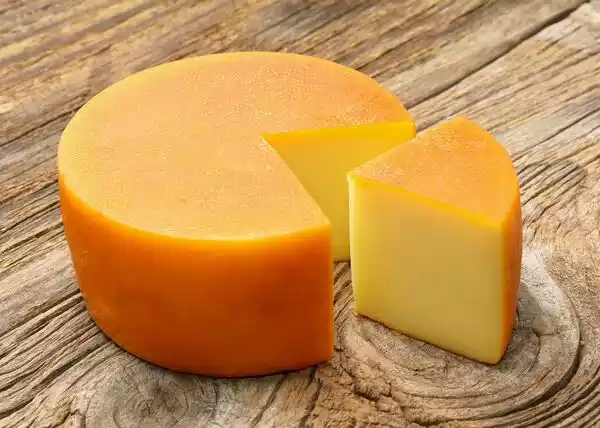Gouda and Edam are two iconic Dutch cheeses with unique characteristics that distinguish them from each other. Gouda, originating from the city of Gouda in the Netherlands, is celebrated for its creamy flavor and diverse textures depending on its age.
Edam, on the other hand, is renowned for its distinctive round shape and mild, slightly salty taste, and it takes its name from the town of Edam in the Netherlands.
What is Gouda Cheese?
Gouda cheese is a Dutch cheese that is renowned for its mild and creamy flavor profile. It is a semi-hard cheese that originates from the city of Gouda in the Netherlands, from which it gets its name. Gouda cheese is typically made from cow’s milk and is characterized by its pale yellow interior and wax-coated rind.

The cheese undergoes a maturation process that can vary in duration, resulting in different textures and flavors. Young Gouda cheese tends to be soft and mild, while aged Gouda develops a firmer texture and a more pronounced, nutty taste.
It is a versatile cheese used in a variety of culinary applications, from cheese platters to sandwiches, and melted in various dishes. Gouda cheese is enjoyed worldwide and is a popular choice for its delightful taste and creamy texture.
What is Edam Cheese?
Edam cheese is a Dutch cheese known for its distinctive, round shape and mild, creamy taste. It takes its name from the town of Edam in the Netherlands, where it was originally produced. Edam cheese is typically made from cow’s milk and has a pale yellow interior with a red or yellow wax coating on the outside.
This wax coating not only preserves the cheese but also gives it its characteristic appearance. The cheese has a smooth and firm texture, making it easy to slice or cut into wedges.

Edam cheese is known for its mild and slightly salty flavor, making it a popular choice for snacking, sandwiches, and cheese platters. Its round shape and appealing appearance have made it a recognizable and widely enjoyed cheese both in the Netherlands and around the world.
Comparison chart of Gouda and Edam cheeses
Here’s a comparison chart for Gouda and Edam cheeses, highlighting their key differences:
| Aspect | Gouda Cheese | Edam Cheese |
|---|---|---|
| Origin | Gouda, Netherlands | Edam, Netherlands |
| Milk Source | Typically cow’s milk | Cow’s milk, sometimes goat or sheep’s milk |
| Fat Content | Generally higher fat content | Lower fat content compared to Gouda |
| Texture | Creamy, can become crumbly with age | Semi-hard, slightly elastic |
| Taste | Sweet, nutty flavor; becomes stronger with age | Mild, slightly salty, nutty; less intense than Gouda |
| Color | Yellowish-orange | Pale yellow |
| Aging Process | Aged from a few weeks to several years; older Gouda is harder and stronger in flavor | Usually aged for a shorter period; retains a milder flavor |
| Rind | Wax or natural rind, often in yellow or red color | Typically covered in red or yellow wax |
| Uses in Cuisine | Used in sandwiches, melted in dishes, and paired with wines; older Gouda is good for grating | Often used in sandwiches, salads, and snacks; good for melting |
| Nutritional Differences | Higher in calories and fat due to higher fat content | Slightly lower in calories and fat |
| Popularity and Availability | Popular worldwide, easily available in many countries | Widely available but may be less popular than Gouda in some regions |
| Unique Characteristics | Known for its rich, unique flavor that intensifies with aging; offers a wide range of flavors based on age | Known for its distinctive spherical shape with flattened ends; its mild flavor makes it a versatile cheese |
This chart provides an at-a-glance comparison of the two cheeses, covering aspects like origin, taste, texture, and culinary uses.
Nutritional Comparison chart
Here’s a nutritional comparison chart for Gouda and Edam cheeses.
The values are typically based on a 100g serving:
| Nutrient | Gouda Cheese | Edam Cheese |
|---|---|---|
| Calories | 356 kcal | 314 kcal |
| Total Fat | 27g | 24g |
| Saturated Fat | 17g | 15g |
| Cholesterol | 110 mg | 95 mg |
| Protein | 25g | 25g |
| Carbohydrate | 2.2g | 1.4g |
| Fiber | 0g | 0g |
| Sugars | 2.2g | 1.4g |
| Calcium | 700 mg | 730 mg |
| Sodium | 819 mg | 700 mg |
| Vitamin A | 330 IU | 300 IU |
| Vitamin B12 | 2.65 µg | 2.5 µg |
| Phosphorus | 546 mg | 510 mg |
This chart shows that both Gouda and Edam are rich in protein and calcium, with similar nutritional profiles. Gouda has slightly more calories and fat, while Edam has marginally less cholesterol and sodium. Both cheeses contain small amounts of carbohydrates and no fiber, with a similar vitamin content.
Origin and History
Gouda and Edam cheeses both originate from the Netherlands, with histories dating back several centuries. Gouda, named after the city of Gouda, began production in the late 12th century and quickly gained popularity for its rich, unique flavor.
It was traditionally traded in the city’s cheese market, a practice that continues today. Edam, from the town of Edam in North Holland, has been a notable Dutch cheese since the 14th century.
Its milder flavor and firmer texture made it an ideal cheese for long sea voyages, contributing to its global spread during the Dutch Golden Age. Both cheeses reflect the rich dairy traditions of the Netherlands and remain popular worldwide.
Production Process of Gouda Cheese
The production of Gouda cheese involves a distinctive process that begins with pasteurizing cow’s milk. After adding cultures and rennet for curdling, the curd is cut, stirred, and heated, which helps in separating the whey.

The curds are then pressed into circular molds, giving Gouda its classic shape. A key step is washing the curd, which removes lactose and contributes to Gouda’s sweet flavor. The cheese is then soaked in a brine solution, which adds flavor and acts as a preservative.
After brining, Gouda is left to age, which can range from a few weeks to several years. As it ages, Gouda develops a firmer texture and its flavor becomes more complex, ranging from mild and creamy in young cheeses to rich and caramel-like in older ones.
Production Process of Edam Cheese
The production process of Edam cheese is similar to Gouda but with some distinct steps. It starts with partially skimmed, pasteurized cow’s milk, to which cultures and rennet are added for curdling. The curd is cut, heated, and stirred, separating it from the whey. Unlike Gouda, Edam’s curds are not washed, resulting in a slightly higher acidity and firmer texture.
The curds are then pressed into spherical molds, creating Edam’s characteristic round shape. The cheese is soaked in a brine solution for flavor and preservation and then coated with wax, often red or yellow, to prevent spoilage.

Aging Edam is a shorter process compared to Gouda, typically lasting a few weeks to a few months, which helps maintain its mild, nutty flavor and slightly springy texture.
Physical Characteristics – Gouda Cheese vs Edam Cheese
Gouda and Edam cheeses have distinct physical characteristics that set them apart:
Gouda Cheese:
- Shape and Size: Traditionally, Gouda comes in a flat wheel shape.
- Color: The cheese itself is a creamy yellow. Younger Gouda is softer and lighter in color, while aged Gouda turns a deeper yellow and becomes firmer.
- Texture: Young Gouda is smooth and creamy. As it ages, it becomes harder and can develop a granular texture.
- Rind: Gouda cheese is often coated with a wax rind, which can be red, yellow, or black, depending on the age and type of the cheese.
- Size Variation: It can vary in size, but typically, Gouda wheels are quite large.
Edam Cheese:
- Shape and Size: Edam is known for its distinctive spherical shape, often with a flattened top and bottom.
- Color: The inside of Edam cheese is pale yellow, generally lighter than Gouda.
- Texture: Edam has a semi-hard texture, which is slightly elastic and smooth.
- Rind: The rind is typically covered in red or yellow wax, which helps to preserve the cheese.
- Size Variation: Edam balls are smaller compared to the large wheels of Gouda.
Gouda is known for its wheel shape, deeper yellow color, and varying texture based on age, while Edam is recognized for its unique spherical shape, lighter color, and consistent semi-hard texture. The wax coatings on both cheeses are not only distinctive in terms of color but also serve as an indicator of the type of cheese.
Flavor Profile of Gouda Cheese
Gouda cheese is renowned for its rich and unique flavor profile, which varies depending on its age. Young Gouda, aged for a few weeks, is mild, soft, and slightly sweet with a creamy texture. As it ages, the flavor deepens and becomes more complex, with a pronounced nutty and caramel-like taste.
Aged Gouda, which can be matured for several years, develops a robust, slightly tangy flavor with hints of butterscotch and a firmer, almost crumbly texture. This complexity makes Gouda a versatile cheese, suitable for a range of culinary uses, from table cheese to a flavorful addition in cooked dishes. Its ability to cater to a wide range of palates, from mild and creamy to strong and savory, contributes to its popularity worldwide.
Flavor Profile of Edam Cheese
Edam cheese is known for its subtly sweet, mildly nutty flavor that is less intense than many other cheeses, including Gouda. Characteristically, Edam has a slightly salty undertone that complements its gentle, creamy taste. The texture is smooth and semi-soft, which further enhances its mild and palatable flavor profile.
Unlike Gouda, Edam’s flavor doesn’t vary much with age; it maintains its mildness even when aged, making it a popular choice for those who prefer a less assertive cheese. Its delicate, unobtrusive taste makes it a versatile cheese in cooking, pairing well with fruits and wines, and it’s especially favored in sandwiches and salads for its ability to blend seamlessly with other ingredients.
Culinary Uses: Gouda Cheese and Edam Cheese
Gouda and Edam cheeses are both versatile in the kitchen, each bringing its unique qualities to a range of dishes. Gouda, with its rich and varying flavors, is excellent in grilled cheese sandwiches, melted in casseroles, and used in cheese sauces.

Young Gouda’s creaminess enhances soups and salads, while aged Gouda is perfect for grating over pasta and baked dishes for a robust flavor. On the other hand, Edam, with its mild and slightly nutty taste, is a great addition to cheese platters, sandwiches, and salads.
Its ability to melt well without becoming stringy makes it ideal for fondues, pizza toppings, and snack foods. Both cheeses pair wonderfully with fruits, nuts, and a variety of wines, making them a favorite in both cooking and as standalone snacks.
Gouda Cheese and Edam Cheese: Health Benefits
Both Gouda and Edam cheeses offer several health benefits due to their rich nutritional content. They are excellent sources of high-quality protein, essential for muscle repair and growth. These cheeses are also rich in calcium, crucial for healthy bones and teeth.
Gouda cheese, in particular, is noted for its Vitamin K2 content, which plays a role in bone and cardiovascular health. Additionally, both cheeses provide important B vitamins, including B12, essential for brain health and energy metabolism.
While they are nutritious, it’s important to consume them in moderation due to their high fat and sodium content. For those looking for healthier options, Edam cheese, with its slightly lower fat content, can be a better choice.
Their probiotic content, especially in the aged varieties, can also support gut health. Overall, when consumed as part of a balanced diet, Gouda and Edam can contribute positively to overall health.
Availability and Market Preferences
Gouda and Edam cheeses are widely available and enjoy varying degrees of popularity globally. Gouda, particularly renowned for its rich flavor and versatility, is a staple in many countries and can be found in various forms, from young and creamy to aged and intense. Its popularity is reflected in its broad presence in supermarkets, cheese shops, and online retailers.
Edam, with its distinctive round shape and milder taste, is also globally recognized, though its market presence is somewhat overshadowed by Gouda’s. It’s especially favored in Europe and North America and often sought for its lower fat content and subtle flavor, making it a choice for lighter cheese options.
Which is better Gouda or Edam?
Determining whether Gouda or Edam cheese is “better” largely depends on personal taste preferences and the intended use. Gouda is ideal for those who enjoy cheese with a rich, complex flavor, especially when aged, and a versatile texture that ranges from creamy to crumbly.
It’s great for adding depth to dishes or enjoying a standalone snack. Edam, on the other hand, is perfect for those who prefer a milder, nuttier taste and a consistently semi-hard texture.
It’s a great choice for a light, unobtrusive addition to meals and pairs well with a variety of foods without overpowering them. Ultimately, the choice between Gouda and Edam comes down to individual flavor preferences and culinary needs.
What is the most healthy cheese?
Determining the “most healthy” cheese depends on specific dietary needs and health goals. Generally, cheeses like Mozzarella, Feta, Cottage Cheese, Ricotta, and Parmesan are considered healthier options due to their lower fat content and higher protein levels. Cottage cheese, in particular, is low in fat and calories while being high in protein, making it a popular choice for weight management and muscle building.
Feta and Mozzarella are lower in calories than many other cheeses and also offer beneficial nutrients like calcium and protein. Parmesan, while higher in sodium, is rich in calcium and often used in smaller amounts due to its strong flavor.
Conclusion
Gouda and Edam cheeses, both hailing from the Netherlands, offer distinct experiences in terms of taste, texture, and culinary use. Gouda is celebrated for its rich, versatile flavor that intensifies with age, making it a favorite for both mild cheese lovers and those who prefer a more robust taste.
Edam, known for its mild, nutty flavor and distinctive spherical shape, caters to those seeking a subtler cheese experience. Despite their differences, both cheeses share a rich heritage, nutritional benefits, and widespread availability, making them enduring favorites in the global cheese market.
